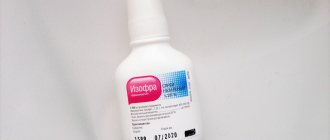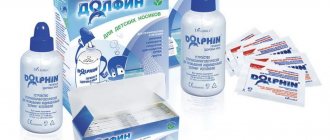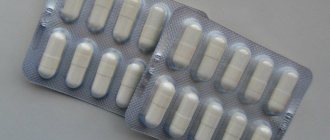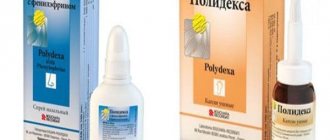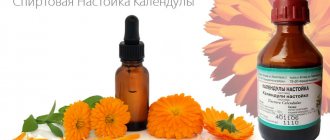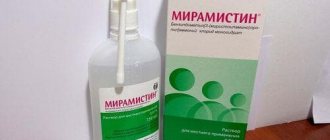Pharmacological effects
Glucocorticosteroid of synthetic origin for local use. It has anti-inflammatory, decongestant, antiallergic and immunosuppressive properties. Reduces swelling of the nasal mucosa and mucus secretion. The positive effects of the medicine are not felt the first time. Relief from a runny nose is noticed after several doses of starting to take the medicine. The product is intended during:
- allergic rhinitis during the season;
- constant allergic and vasomotor runny nose.
Available
: nasal spray with dispenser.
Active ingredient
: 50 mcg beclomethasone dipropionate.
Additional components
: · benzalkonium chloride; · phenylethanol; · 80 polysorbate; · dextrose anhydride; · MCC; · sodium carboxymethylcellulose; · hydrochloric acid; · purified water.
Directions for use and dosage
The basic rules for using the drug are the same for everyone:
- Before first use, you need to remove the protective plastic ring, which is located in the gap between the dispenser-applicator and the screw-on part.
- Clean the nasal cavity by rinsing.
- Shake the product vigorously and then remove the protective cap.
- Place the bottle in your hand so that its bottom rests on the thumb, and the index and middle fingers hold the drug on opposite sides, close to the nasal applicator.
- Press the dispenser vigorously a couple of times until a “cloud” of the medicine appears. This manipulation should be carried out before the first use of the aerosol and in the future, provided that there was a long pause between uses of the drug.
- Take a small breath through your nose.
- The nasal passage, free from injection, must be covered with the finger of your free hand.
- Insert the tip of the applicator into the free nostril.
- Tilt your head forward slightly, trying to achieve a perpendicular position of the aerosol.
- Press the dispenser, injecting a therapeutic dose of the drug into the nasal cavity, while inhaling.
- Inhale through your mouth.
- Repeat the same manipulation with the second nasal passage.
- After finishing the procedure, clean the tip of the applicator with a napkin and close it with a protective cap.
It is recommended to clean the nasal applicator once a week to prevent it from becoming clogged. To do this, you need to disconnect it by pressing on its lower part, rinse it under running water along with the protective cap, dry it and reassemble the bottle.
The drug is prescribed to adults and children over the age of 12 years, in the amount of 1-2 doses of spray in each nasal passage up to 2 times a day (usually in the morning and evening). For children 6-12 years old, Nasobek is dosed at 50 mcg in the morning and evening; if necessary, the amount of the drug is adjusted by the doctor. In this case, the maximum dose of the drug per day for adults and children over 6 years of age will be 400 mcg per day.
Nasobek is not used during pregnancy in the first trimester - the first 12 weeks from conception are an absolute contraindication to the use of the drug. Starting from the second and third trimesters, Nasobek can be used during pregnancy after the preliminary conclusion of a doctor that the expected benefit to the pregnant woman will exceed the likely risk to the fetus.
The drug should be used with extreme caution during lactation.
Pharmacokinetics
When inhaled in prescribed dosages, the medicine does not have an increased positive effect. During intranasal use, the drug is immediately absorbed through the nasal mucosa. The remainder of the spray is usually swallowed. Absorption from the gastrointestinal tract is not increased. The binding process to plasma proteins is 87%. Metabolism and excretion
A large dose of the drug that enters the gastrointestinal tract is metabolized by the liver T1/2 - 15 hours. From 35 to 76% of the spray, regardless of the method of application, is excreted within 96 hours along with feces. From 10 to 15% of the drug is excreted through the kidneys.
Mode of application
The average cost of medicine in Russia is 178 rubles per bottle.
The medication is used intranasally. For adults and children over 12 years of age, the prescribed dosage is 50-100 mcg in the nasal sinuses 2 times a day. From 6 to 12 years, the daily dosage should not exceed 400 mcg, divided into 2 doses. It is best to administer 1 dose into each nostril. The duration of therapy is selected individually, usually until complete recovery. It can also be prescribed for sinusitis, but the treatment regimen for inflammation of the maxillary sinuses must be personally agreed with the doctor, since there are many individual indications.
Before use, as the instructions indicate, the medicine must first be shaken. Then a control injection of the product into the air is performed to check the functionality of the device. When the medicine begins to be released, you need to take the bottle and insert it into the nostril, first holding the other one with your hand. As you inhale, the product is injected through the applicator. The same is done with the second nostril. After completing the procedure, wipe the nozzle with a handkerchief. It is recommended to rinse the applicator under running water once a week.
During pregnancy and breastfeeding
During pregnancy, nasobek is contraindicated only in the first trimester, since during this period the entire body of the fetus is actively formed. In the second and third trimesters, the product should be used with caution. Lactation is not a contraindication, but use is indicated only under medical supervision.
Adverse reactions
When using Nasobek, the following adverse reactions may occur: · irritation of the mucous membrane; · sneezing; burning sensation in the nose or feeling of dryness; · rash or hives; · fungal flora can cause nasopharyngeal infections; angioedema; · rhinorrhea; · headache. Undesirable effects such as: · hemorrhages from the nose are observed less frequently; Conjunctival hyperemia; increased pressure inside the eyes; · myalgia; · feeling of drowsiness; · coughing; · lack of taste; · atrophy of the nasal mucosa. Even less common are side effects such as perforation of the nasal membrane or ulceration of the nasal mucosa. As a result of long-term use of the drug at a dosage of more than 1500 mcg per 24 hours, systemic adverse reactions may occur, including adrenal insufficiency. If the patient uses the medicine in recommended doses, side effects are very rare.
Description and instructions for the drug Nasobek
Nasobek is a medicine that is applied topically to the nasal mucosa and serves to relieve inflammation and swelling caused by allergies.
The active ingredient in the drug is beclomethasone. This is a glucocorticoid compound, which is characterized by low absorption and, accordingly, lack of systemic action. Due to these properties, Nasobek can be taken for a long time, replacing other medications that cause addiction and numerous side effects. Treatment with this drug is indicated for various forms of rhinitis, as well as nasal polyposis. According to the method of application, Nasobek is produced in the form of a spray for spraying into the nasal passages. The instructions for the drug insist on regular and long-term use, as the effect develops gradually, over several days. Before using Nasobek spray, you should clean the mucous surfaces of the nose. Treatment can begin from the age of six. In the presence of infections, including herpes or tuberculosis, the use of Nasobek is limited. Children whose mothers received therapy with any glucocorticoids during pregnancy and lactation should be carefully examined.
Side effects of Nasobek
Sneezing attacks are possible, which occur immediately after spraying Nasobek into the nasal passages. Also, there may be increased mucus secretion (rhinorrhea) or, conversely, dryness in the nose. Cases of damage to the nasal mucosa are described - ulceration, atrophy, even perforation (thinning and rupture) of the nasal septum.
In rare cases, patients using Nasobek developed nasal candidiasis (thrush). There are also allergic reactions into intolerance to this drug.
Restrictions on use
- hemorrhagic diathesis;
- periodic nosebleeds;
- tuberculosis disease;
- fungal and viral infections;
- children under six years of age;
- during pregnancy (first trimester);
- sensitivity to the components of the spray.
It is necessary to prescribe the remedy very carefully during: amoebiasis; acute form of liver failure; · hypothyroidism; recent myocardial infarction; · glaucoma; · ulcers on the nasal membrane; · recent nasal surgeries or injuries; · pregnancy (especially during the second and third trimester); · lactation process.
Contraindications
Nasobek has a fairly large list of contraindications and restrictions on use due to the glucocorticosteroid content in its composition.
It is prohibited to use the spray for treatment when:
- hypersensitivity to any component of the drug;
- viral and fungal nature of the disease;
- frequent nosebleeds;
- tuberculosis of the respiratory system;
- hemorrhagic diathesis.
The drug is also not prescribed in the 1st trimester of pregnancy and in children under 6 years of age.
Particular care is taken if the patient has:
- glaucoma;
- hypothyroidism;
- amoebiasis;
- recent operations in the nasal cavities;
- history of myocardial infarction;
- severe liver failure;
- 2-3 trimesters of pregnancy;
- during breastfeeding.
Using the spray
During the first use of Nasobek, it is necessary to remove the plastic strip, which is located in the middle of the bottle cap and applicator. Step 1: At the beginning of use, you need to shake the bottle a little, then remove the applicator cap. Step 2: use your fingers to secure the bottle at the bottom of the applicator on opposite sides. Step 3: during the first use of the product or during a week's break between its doses, the first portion must be sprayed out. Step 4: Then you need to exhale lightly through your nose. Step 5: The nostril where the spray is not injected must be pressed with a finger. Insert the end of the applicator into the free one, then tilt your head so that the bottle is positioned perpendicularly. Step 6: Next to the open nostrils, you need to take a light breath, simultaneously press the applicator and inject the required dose into the nose. Step 7: Then exhale through your mouth. Step 8: When injecting Nasobek into the other nostril, you need to follow the same steps as when injecting it for the first time. Once all relevant procedures for using the product have been completed, the end of the applicator must be cleaned with a clean cloth and the spray closed. Cleaning the applicator
It is recommended to clean the nasal applicator at least once a week. Otherwise, it will become clogged, which can lead to the collection of various microbes on it. To clean it, you need to lightly press the bottom of the bottle and pull out the applicator. After this, rinse with slightly warmed water and leave to dry. Then the cap and applicator are put back on the bottle.
Instructions for use Nasobek, dosage of nasal spray
The drug is used intranasally (in the nose).
Standard dosages of the spray, according to the instructions for use of Nasobek:
- Adult dosages for administration into one nasal passage: 1-2 doses / 2 times a day. The daily dosage can be increased to 400 mcg (4 doses).
- Children's dosages (6-12 years): 1 dose / 2 times a day.
When a therapeutic effect is achieved, the drug is discontinued, gradually reducing the dose.
Elderly patients do not require dose adjustment.
Application algorithm:
- Clear your nasal passages.
- Unlock the spray mechanism (before first use and after a long break in use). Unlocking is achieved by pressing the dispenser until the first cloud of aerosol appears. Usually a few clicks are enough for this. You should also remove the restrictive half-ring.
- The bottle should be positioned so that its bottom rests on the thumb, and the middle and index fingers are on the bottom.
- Before injecting, you should exhale through your nose and bow your head slightly.
- One nasal passage is pinched with a finger, and an applicator is inserted into the second. The bottle should be positioned perpendicularly.
- At the same time, take a light breath and administer a dose of the aerosol drug.
- Exhale through the mouth.
The nasal applicator should be cleaned at least once a week to prevent the possibility of clogging. To do this, lightly press the bottom of the applicator and detach the nasal applicator. Rinse the applicator and cap with warm water and allow to dry. After this, put the applicator and cap back on the bottle.
Side effects
The instructions warn about the possibility of developing the following side effects when prescribing Nasobek:
- urticaria, skin rashes, Quincke's edema;
- candidiasis;
- headache, weakness and drowsiness, distortion of taste and smell;
- dryness of the mucous membranes of the mouth and nose, bleeding, cough, burning and itching in the nose, rhinorrhea.
Known cases of occurrence:
- ulcers on the nasal mucosa and perforation of the septum;
- decreased growth rate and thinning of bones in pediatric patients;
- conjunctivitis, glaucoma, visual impairment.
Contraindications
Nasobek spray is contraindicated in the following cases:
- hemorrhagic diathesis;
- frequent nosebleeds;
- respiratory tuberculosis;
- fungal infections;
- viral infections;
- children under 6 years of age;
- 1st trimester of pregnancy;
- hypersensitivity to the components of the drug.
The use of the drug is contraindicated in the 1st trimester of pregnancy. The use of the spray in the 2nd and 3rd trimesters of pregnancy is allowed only if the expected benefit to the mother outweighs the possible risk to the fetus.
Nasobek should be used with caution during breastfeeding.
Overdose
With prolonged use of large doses, hypercortisolism may occur. It is necessary to stop using the nasal spray, gradually reducing the dose.
